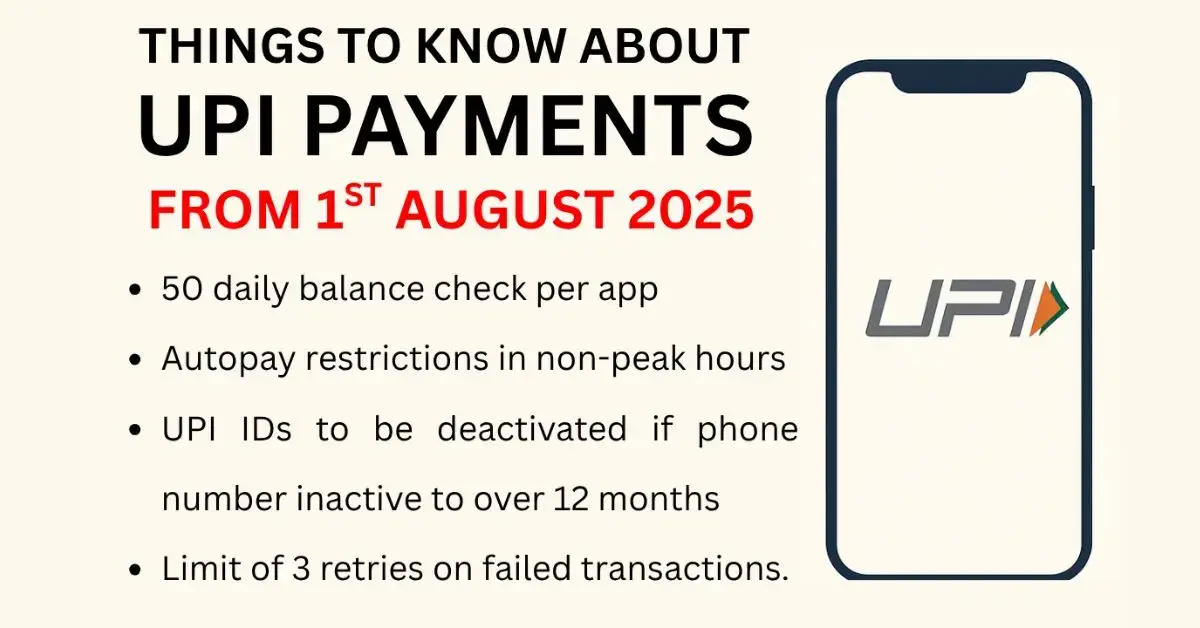UPI New Rules August 2025: Everything You Need to Know Before August 1
India’s favorite digital payment system, UPI, is about to undergo major changes starting August 1, 2025.
Whether you’re a student paying for groceries, a small shop owner, or a business relying on instant transfers, these updates announced by the National Payments Corporation of India (NPCI) will directly impact how you send, receive, and automate payments.
If you’re not prepared, you could face failed transactions, blocked UPI IDs, or delayed bill payments. Let’s break it down so you can stay ahead and avoid disruptions.
Why NPCI is Updating UPI Rules from August 2025
UPI has become the backbone of India’s digital economy, processing over 60 crore transactions daily and even surpassing Visa as the world’s top payment system.
But this explosive growth comes with challenges:
- Network congestion during peak hours.
- Fraud and inactive ghost accounts.
- Heavy usage by high‑volume businesses slowing down ordinary users.
To make UPI faster, safer, and more stable, NPCI is rolling out these new regulations.
New Balance Check Limits – What They Mean for Heavy UPI Users
From August 1, you’ll only be able to check your bank balance 50 times per day per UPI app.
For most casual users, that’s more than enough. But for shopkeepers, gig workers, and businesses tracking payments in real time, hitting this cap could freeze your access until the next day.
Tip to stay safe:
- Spread your usage across two or more UPI apps.
- Use balance alerts from your bank instead of repeatedly refreshing your app.
Autopay Timing Restrictions – Will Your Bills Get Delayed?
Recurring payments—**electricity bills, OTT subscriptions, insurance premiums, SIPs—**will now process mostly during non‑peak hours to reduce network congestion.
While this makes the system more efficient, it could mean delays in payments reflecting as complete on the same day.
Why this matters emotionally:
Imagine your Netflix subscription pausing, or your insurance premium marked late, simply because the system scheduled it later. For businesses, a vendor payment delay can lead to stress and penalties.
What you can do:
Set SMS reminders to confirm payments and keep a backup payment mode like a debit card handy.
Inactive SIM Numbers and UPI Deactivation – Are You at Risk?
If your phone number linked to your UPI account has been inactive for 12 months or more, your UPI ID will automatically be deactivated.
This move reduces fraud and cleans up unused accounts, but it can catch users by surprise—especially if you use a secondary SIM just for banking.
Action Plan:
- Check which SIM your UPI ID is linked to.
- Reactivate or port inactive SIMs before August 1.
- Update your KYC with your bank to avoid disruption.
Failed Payment Retry Limit – Avoid Getting Stuck
Currently, when a transaction fails, many users keep tapping “retry”—sometimes triggering duplicate deductions. From August 1, you can only retry a failed payment three times per transaction.
If it doesn’t go through, you’ll need to wait or switch to another app.
How to Prepare Before August 1 to Avoid Transaction Failures
- Update all your UPI apps to their latest versions.
- Verify your registered mobile number is active and valid.
- If you’re a heavy user, split your transactions across multiple apps.
- Set reminders for autopay transactions and confirm they clear on time.
- Educate your staff or customers if you run a business, so no one panics during the change.
Why These Rules Help in the Long Run
UPI isn’t just a convenience anymore—it’s India’s gateway to a cashless, global future.
By enforcing these limits, NPCI is ensuring that the system remains:
- Stable and fast even as volumes grow.
- Secure by cutting inactive accounts and fraud risk.
- Accessible to all users, not just heavy businesses.
Final Word – Stay Ahead, Stay Hassle‑Free
These changes may feel like speed bumps, but they’re actually paving the way for better, safer, and smoother digital payments.
If you rely on UPI for daily life or business, take these steps today to avoid stress and keep your payments flowing smoothly.
💡 Stay Updated on UPI & Finance:
Don’t miss future updates like this. Subscribe to our newsletter to get tips, alerts, and money hacks straight to your inbox—before anyone else.










